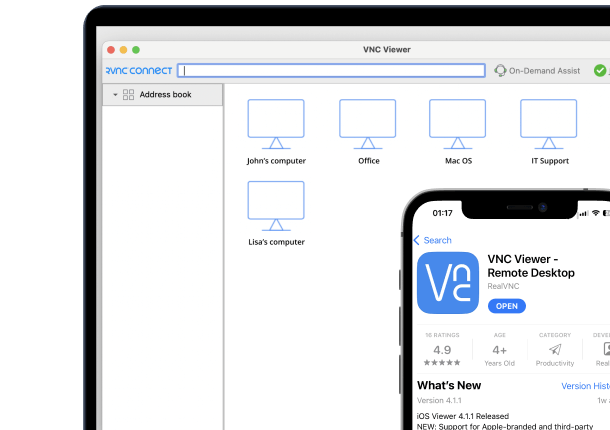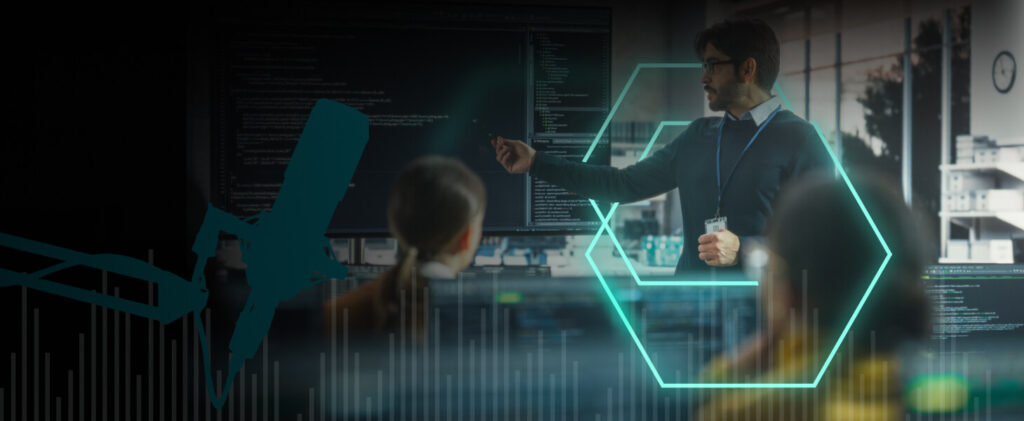Remote infrastructure management (RIM): What is it?
Remote Infrastructure Management (RIM) means remotely managing and overseeing your IT infrastructure. This includes hardware, software, network components, and IT services. With RIM, you can manage and monitor your IT systems without on-site staff, increasing efficiency, cost savings, and security. An effective RIM solution is crucial for maintaining a competitive edge in today’s digitized business environment.
6 key components of RIM
Remote monitoring and management (RMM): RMM means continuous and proactive monitoring of IT infrastructure components like servers, networks, databases, and applications. This proactive approach helps to identify and fix issues before they impact business, with minimal downtime and optimal performance.
Network management: This includes remote monitoring and management of network infrastructure like routers, switches, and wireless access points across remote locations. Good network management means seamless connectivity and robust security to protect data.
Security management: RIM includes management of your security infrastructure like firewalls, antivirus software, and intrusion detection systems. With remote security management, you can protect your IT environment from cyber threats.
Server and desktop management: This means remote administration of servers, data centers, and end-user devices like PCs and laptops. Tasks include software updates, troubleshooting, and performance optimization so all devices run efficiently and securely.
Application management: RIM services cover application management, performance monitoring, incident reporting, and updates. So applications run smoothly, and any issues are fixed.
Integration with IT systems: RIM integrates with existing IT systems by using cloud-based platforms and advanced remote access technologies. This integration means centralized management and coordination so IT teams can manage infrastructure from anywhere in the world. Secure communication channels and encryption mean data is protected during remote interactions.
Why is remote infrastructure management important?
Remote Infrastructure Management (RIM) is vital for businesses today as it has a huge impact on operational efficiency, cost savings, and security. Here are the reasons why RIM is important:
Operational efficiency
RIM allows you to manage your IT infrastructure from a remote location with no need to have on-site staff and physical infrastructure. This centralized approach ensures consistency and security across distributed systems, perfect for companies with multiple locations or remote workforce. By reducing downtime and maintaining business efficiency, RIM significantly contributes to enhanced productivity.
Cost savings
By outsourcing IT infrastructure management to service providers, you can significantly reduce operational costs by avoiding the need for in-house training or hiring highly skilled IT professionals. This means huge cost savings as you can eliminate the costs of office space, equipment, and utilities.
Security
RIM provides employees with distributed access and authentication mechanisms, ensuring compliance with data governance frameworks like GDPR. It also automates manual tasks like patch management and vulnerability assessment, reducing cyber threats.
Supporting remote work and distributed teams
External service providers play a crucial role in RIM for companies with multiple locations or remote workforces. It’s a centralized approach to managing distributed systems so all employees can access IT services seamlessly. It supports remote work and distributed teams by managing IT infrastructure efficiently and securely.
RIM is essential because it supports remote work and distributed teams due to its operational efficiency, cost savings, and security. Its centralized approach and automation make it a must-have if you want to stay competitive in this digital era.
Practical applications of remote infrastructure management
Global enterprises: Large organizations with multiple locations use remote infrastructure management solutions to manage their IT infrastructure across multiple sites. This means no need for on-site IT teams, huge cost savings, and streamlined operations.
Healthcare: Hospitals and clinics use RIM to monitor and maintain their critical IT systems, like electronic health records and diagnostic equipment, so patient care is uninterrupted.
Financial services: Banks and financial institutions use RIM to manage their complex IT environments to meet regulatory requirements and protect customer data from cyber threats.
Manufacturing: Manufacturers use RIM to manage their production systems and supply chain networks to optimize performance and minimize downtime through proactive maintenance and monitoring.
What does the remote infrastructure management market look like today?
The RIM market has experienced significant growth in recent years, driven by factors such as increasing reliance on technology, the need for cost optimization, and the demand for enhanced security in data center management.
As more businesses recognize the benefits of RIM services, the market is expected to continue expanding in the coming years, offering potential opportunities for businesses and IT service providers alike.
What are some types of remote infrastructure management services?
In this section, we’ll explore some of the most common types of RIM services available to businesses today:
Managed desktop services
Managed desktop services involve the remote monitoring and managing of end-user devices, such as PCs, laptops, and mobile devices. These services enable businesses to ensure their devices are secure, up-to-date, and functioning optimally. RealVNC’s software, RealVNC Connect, with its components RealVNC Viewer and RealVNC Server, provides comprehensive managed desktop services, allowing organizations to access and control their devices from anywhere seamlessly. Get a free trial of RealVNC Connect right now and check out what it can do for you!
Managed server services
Managed server services encompass the remote management of an organization’s servers, including monitoring, maintenance, and troubleshooting tasks. RealVNC’s Remote Monitoring and Management (RMM) product, RPort, offers managed server services, helping businesses achieve greater efficiency and reduce downtime.
Managed security services
Managed security services involve the remote monitoring and managing an organization’s security infrastructure, such as firewalls, antivirus software, and intrusion detection systems. RealVNC Connect incorporates built-in security features, ensuring your remote infrastructure remains protected against threats.
Managed applications services
Managed applications services include the remote monitoring and management of an organization’s software applications, such as performance monitoring, incident reporting, and application updates. These services help businesses maintain optimal application performance and address any issues that may arise.
Managed network services
Managed network services involve the remote monitoring and managing an organization’s network infrastructure, including routers, switches, and wireless access points. These services help businesses maintain network performance, troubleshoot issues, and ensure network security.
What will remote infrastructure management look like in the future?
As businesses continue to evolve and adopt more advanced technologies, the future of Remote Infrastructure Management (RIM) is set to undergo significant transformations. In its FutureScapes report, IDC predicted that digital infrastructure will play a crucial role in enhancing operational resilience, security, and productivity for businesses worldwide. Here are some key trends and developments that will shape RIM in the coming years:
Increased automation and AI integration
The future of RIM will likely see a greater reliance on automation and artificial intelligence (AI) for managing IT infrastructure. AI-powered tools will help automate routine tasks like network monitoring, incident detection, and security management, allowing IT teams to focus on more strategic initiatives. Predictive maintenance will also become more prominent, with AI helping to identify potential system failures before they occur, minimizing downtime and reducing costs.
Expansion of edge computing
Edge computing is a distributed computing model where data processing happens closer to the physical location where the data is generated, rather than being sent to centralized data centers. This approach reduces latency and bandwidth usage, improving response times for critical applications. As edge computing grows, RIM must adapt to manage these distributed environments.
This shift will drive the need for more sophisticated monitoring tools to manage and secure infrastructure across centralized data centers and remote edge locations. Businesses will require RIM solutions to handle the increased complexity and ensure seamless integration between cloud and edge environments.
Enhanced cybersecurity protocols
As cyber threats become more sophisticated, RIM solutions will increasingly incorporate advanced security measures. Multi-layered defense strategies, including zero-trust security models, will become standard practice.
This approach ensures that no user or device, whether internal or external, is trusted by default, and every access request must be verified. The rise of AI-driven threat detection will also help RIM providers proactively identify and respond to security breaches in real time.
Growth in hybrid and multi-cloud management
With businesses increasingly adopting hybrid and multi-cloud strategies, RIM will evolve to provide comprehensive management across multiple cloud environments. Future RIM tools must offer seamless integration and control across public, private, and hybrid cloud infrastructures, ensuring consistent performance, security, and compliance.
Sustainability and green IT
As organizations look for ways to reduce their carbon footprint, sustainability will play a more prominent role in RIM. Future RIM solutions will incorporate energy-efficient technologies and practices that optimize power usage across data centers and remote infrastructure. This focus on green IT will help businesses meet regulatory requirements and align with corporate social responsibility goals.
Summary
Remote infrastructure management is a powerful tool that enables businesses to optimize their IT infrastructure, reduce costs, and improve security. With a growing market and a range of services available, RIM presents a valuable opportunity for organizations looking to stay ahead in today’s competitive landscape.
RealVNC’s suite of products, including RealVNC Connect and RPort, offers comprehensive RIM solutions, ensuring that your business remains at the forefront of technology and innovation. Get a free 14-day trial and start your journey right now!






